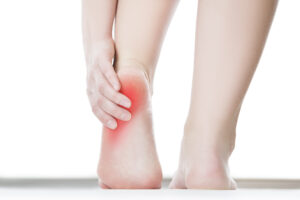Plantar Fasciitis
 What is Plantar Fasciitis?
What is Plantar Fasciitis?
The plantar fascia (PF) is a bundle of strong connective tissue which runs the entire length of the sole of the foot. It fans out from the heel running towards the toes. The PF is important for maintaining strength and arch of the foot. Due to the huge forces placed on the foot when you are standing or moving (between 3-7 times your bodyweight), the plantar fascia is put under a lot of strain and the tissue may start to break down causing pain.
How do I Know if I Have Plantar Fasciitis?
Heel pain is very common, however not all heel pain is caused by plantar fasciitis. Causes of heel pain are very diverse and include: fat pad trauma, nerve impingement, heel spurs, arthritis, gout and inappropriate footwear choice. For this reason, it’s important to get a correct diagnosis from a professional before you start treating the problem.
What Causes Plantar Fasciitis?
Some of the most common causes are:
- Rapid increase or high bodyweight (e.g. during pregnancy or weight gain)
- Increase or change in activity – (e.g. a sudden increased training load or type)
- Muscle imbalance – (e.g. calf or hamstring tightness)
- Poor shoe selection – (e.g. inappropriate shoes or rapid change into new shoes)
- Occupation related stresses (e.g. prolonged standing on hard surfaces)
 Treatment for Plantar Fasciitis
Treatment for Plantar Fasciitis
Conservative (non-surgical) treatment is usually enough and research suggests an average of 85% of people enjoy a successful recovery over 18 months. So be prepared, full recovery may take some time. There are a large variety of treatment options available, but not every treatment will necessarily work for every patient. So it’s often a case of working with your podiatrist to find what works for you. We often find a tailored approach makes a big difference when it comes to your recovery.
Pain Reduction
There are a number of ways we can help you reduce the pain of plantar fasciitis including:
Rest – Relative rest and activity modification. You may not need to stop all activity
Ice – Ice massage (roll under your foot with a frozen water bottle)
Strapping – Reduces inflammation, maintains your arch profile, reducing strain/tension and pain
Massage – Massage under heat with topical NSAID gels such as Voltaren
Stretching – Calf stretches are essential for those with poor ankle range of motion
Pre-loading exercises – Warming up the foot before getting up from rested position
Orthotics – Prescribed by your podiatrist to help the foot function properly and keep your heel more comfortable
Footwear – Good footwear is essential for support and comfort
Medication – Oral over the counter medications such as Ibuprofen or Diclofenac
Long Term Solution
As with most conditions getting the correct diagnosis in the first place is so important and with 51 different causes of heel pain, this is especially important with suspected plantar fasciitis. The sooner you get a correct diagnosis and treatment starts, the sooner you will be pain free.
Plantar Fasciitis is essentially a disease process with a mechanical component that requires mechanical correction to help rest and heal the injured tissue.
If strapping is successful in removing the load on the plantar fascia, then the same effect can be replicated by some type of medical insole and appropriate footwear – this method of treatment is supported by published research.
The type of insole used will be dependant on a number of factors like what sort of shoes you wear, sports involvement, length and duration of the problem, as well as previous treatments. So insole choice is best discussed with your podiatrist.
Over the counter insoles can help some people. But bear in mind you may not have over the counter feet.
Stretching and a combination of some of the other pain reduction strategies discussed are recommended in targeting this condition.
Still in Pain?
Are you are feeling like you have tried everything but are still in pain?
Do you feel like you have seen every health practitioner you can about your heel pain?
We have a track record of diagnosing and successfully treating cases that have previously proven difficult to resolve and we’d love to help you get back on your feet doing what you love.


 What is Plantar Fasciitis?
What is Plantar Fasciitis? Treatment for Plantar Fasciitis
Treatment for Plantar Fasciitis
Good day , my name is Thabile I have pain under my feat ingles planter since I was pregnant 2020 is more than 2year n I count ,